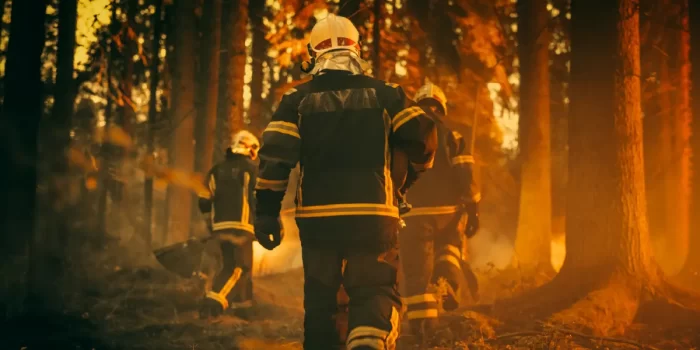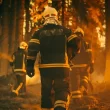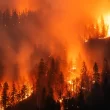Introduction
Wildfires have become increasingly frequent and severe due to climate change, prolonged droughts, and human activities. Effective wildfire firefighting tactics require a combination of science, technology, and strategic planning. This article examines the most effective strategies used in wildfire suppression, highlighting the latest advancements and best practices based on scientific research.
1. Direct Attack Strategies
Direct attack methods involve containing wildfires by applying suppression techniques directly to the fire’s edge. These strategies are employed when fire behavior is predictable and conditions allow for safe engagement by firefighters.
Hand Crews and Fire Lines
Hand crews play a critical role in wildfire suppression by manually creating firebreaks using tools such as chainsaws, shovels, and pulaskis. These fire lines remove vegetation and create barriers that slow or stop the fire’s spread. Bulldozers and heavy equipment are often deployed in more extreme conditions to widen and reinforce these firebreaks, improving containment efficiency.
Water and Retardants
Fire engines, helicopters, and fixed-wing aircraft are used to deliver water and fire retardants to active fire zones. Water is typically used to cool flames and reduce fire intensity, while retardants create chemical barriers that slow the progression of wildfires. These suppression techniques are most effective when combined with ground operations, where firefighters can reinforce treated areas.
Foams and Gels
Fire suppression foams and gels enhance the effectiveness of water by increasing its adhesion to burning materials, prolonging cooling effects. These agents are particularly useful in preventing re-ignition, making them valuable tools in structure protection and perimeter control.
2. Indirect Attack Strategies
When direct attacks are too dangerous or ineffective, firefighters employ indirect tactics that leverage environmental barriers and controlled burns to slow wildfire advancement.
Backburning (Defensive Burning)
One of the most widely used indirect tactics, backburning involves deliberately setting controlled fires ahead of an approaching wildfire. By eliminating combustible fuel in a controlled manner, these burns create a buffer zone that prevents the main fire from spreading further. Skilled personnel carefully monitor backburning operations to ensure they remain within designated containment lines.
Firebreak Construction
Firebreaks are strategically constructed barriers designed to prevent fire spread by removing vegetation, soil, or other combustible material. These can be natural features such as rivers and ridges or man-made structures like roads and trenches. Effective firebreaks require careful planning to align with fire behavior predictions and weather conditions.
Aerial Suppression
Aerial firefighting assets, including helicopters and large air tankers, are used to drop water and retardants in remote or high-risk areas. Drones equipped with thermal imaging cameras help identify hotspots and provide real-time data to ground crews, enhancing coordination and efficiency in fire suppression efforts.
3. Prescribed Burns: Preventative Wildfire Management
Prescribed, or controlled, burns are carefully managed fires that reduce excess vegetation before wildfires occur. This proactive measure serves multiple purposes:
- Decreasing fuel loads: By intentionally burning brush and small trees in a controlled setting, prescribed burns remove materials that could otherwise fuel severe wildfires.
- Promoting ecosystem health: Fire plays a natural role in many ecosystems, helping regenerate soils, remove invasive species, and encourage the growth of fire-adapted plants.
- Reducing wildfire intensity: Communities that regularly conduct prescribed burns experience fewer devastating wildfires because there is less fuel available to support large-scale fire outbreaks.
4. Fire-Resistant Landscapes and Urban Planning
Wildfire risk can be significantly mitigated through proper land management and urban planning strategies. By integrating fire-resistant landscaping and building practices, communities can enhance resilience against wildfires.
Defensible Space Creation
Creating defensible space around homes and structures is one of the most effective ways to reduce wildfire risk. This involves:
- Removing flammable vegetation within a 30-100 foot radius around structures.
- Using gravel or non-combustible ground cover instead of dry grass or mulch.
- Pruning tree branches to prevent flames from reaching rooftops.
Fire-Resistant Building Materials
Modern building materials and design techniques improve structural resilience against wildfires. Homes constructed with non-combustible roofing, ember-resistant vents, and fire-resistant siding are less likely to ignite. Additionally, installing dual-pane windows can prevent heat from shattering glass, which reduces fire intrusion.
Smart Zoning and Development
Limiting construction in high-risk wildfire zones is a crucial component of fire prevention. Urban planners and policymakers enforce fire-safe building codes and implement zoning laws to ensure communities are built in defensible areas, reducing overall vulnerability.
5. Technological Advances in Wildfire Fighting
Advancements in science and technology are transforming how wildfires are detected, monitored, and suppressed.
Drones for Surveillance
Drones equipped with high-resolution cameras and infrared sensors provide real-time fire mapping and monitor fire behavior from above. These UAVs allow firefighters to track fire movements in hazardous areas without putting personnel at risk.
AI and Machine Learning
Artificial intelligence and machine learning models analyze weather conditions, fuel loads, and terrain data to predict wildfire spread. These predictive models enable emergency responders to allocate resources more effectively and implement proactive suppression strategies.
Satellite Monitoring
NASA and NOAA utilize satellite imagery to detect wildfires early and track their progression. These satellite systems provide invaluable data for fire managers, helping coordinate response efforts and assess damage.
6. The Role of Climate Change in Wildfire Behavior
Scientific evidence confirms that climate change is exacerbating wildfire conditions worldwide. Key contributing factors include:
- Rising global temperatures, which dry out vegetation and increase fire susceptibility.
- More frequent and severe droughts, intensifying fire hazards.
- Extreme weather events, such as high winds and heatwaves, accelerating fire spread.
Conclusion
Wildfire firefighting requires a comprehensive approach that integrates traditional suppression tactics, modern technology, and proactive land management strategies. As climate change continues to drive an increase in fire activity, ongoing investment in research, innovation, and policy improvements is essential to protecting communities and ecosystems.
References
- National Interagency Fire Center (NIFC). (2023). Wildland Fire Management. Available at: https://www.nifc.gov
- U.S. Forest Service. (2023). Fire Science & Management. Available at: https://www.fs.usda.gov/science-technology/fire
- NASA Earth Observatory. (2023). Wildfires and Climate Change. Available at: https://earthobservatory.nasa.gov/global-maps/MOD14A1_M_FIRE
- International Association of Wildland Fire (IAWF). (2023). Advancements in Wildfire Suppression. Available at: https://www.iawfonline.org/resources/
- National Oceanic and Atmospheric Administration (NOAA). (2023). Wildfire Monitoring and Prediction. Available at: https://www.noaa.gov














